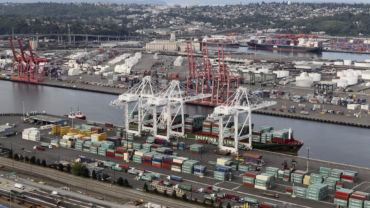International tax laws on e-commerce may change the industry and global trade — perhaps not for the better, resulting in higher consumer prices
E-commerce has enjoyed such a meteoric rise over the past decade that ordering pretty much anything online and receiving it within a few days is now routine for consumers all over the world.
Retail e-commerce sales rose to $6.3 trillion in 2023, from $1.8 trillion in 2016, and are expected to grow to $8.1 trillion by 2026, with 4.5 billion users worldwide — or roughly half the population of the planet, according to data tracking site Statista. What’s more, by 2026, e-commerce is expected to make up 24% of all retail sales, up from 18.8% in 2021.
Though retail giants like Amazon and China’s Alibaba dominate the e-commerce market, most of this explosive growth can be attributed to small- and medium-sized businesses selling their goods and services online. Of course, the pandemic only juiced the machine even more. In 2021 alone, the number of e-commerce websites grew from 9.7 million to 19.8 million, and there are now 26.5 million e-commerce sites operating worldwide.
The economics of global e-commerce may soon be changing, however, possibly making goods more expensive and forcing small business owners to pay much closer attention to international trade laws. That’s because, until now, the growth of e-commerce has been helped along by simplified laws and processes, allowing small online sellers to flourish and the economy to expand. Now, however, lawmakers and regulators, spurred on by governments in search of increased revenues, are targeting online sellers and consumers by seeking to impose duties and taxation that will increase costs and reduce the speed of e-commerce — both of which are hallmarks of e-commerce’s exponential growth.
New legislation and digital customs duties
In the United States, for example, lawmakers have proposed legislation that would lower the de minimis dollar amount (currently $800) under which e-commerce retailers can import goods duty-free and restrict certain non-market-economy countries (China, mostly, but also Russia, Vietnam, and Belarus) from taking advantage of simplified trade processes under de minimis. And in late-February, members of the World Trade Organization (WTO) will consider whether to lift a long-standing moratorium on customs duties and tariffs for electronic transmissions — those products and services that are purely digital in nature, such as cloud-based software, e-books, music, educational materials, and art.
In both cases, governments see dollar signs, but according to trade experts, the extra costs these measures could impose are likely to fall disproportionately on small businesses and consumers. In addition to paying duties on goods they have previously imported for free, small businesses would likely have to adhere to formal international trade requirements and hire customs brokers to facilitate their import/export transactions, which would increase their business costs. These additional costs could also impede the ability of US e-sellers to compete in the global marketplace, in which foreign sellers frequently undercut the price of US goods. Extra costs could also restrict or prohibit certain micro-sellers in impoverished countries from doing business online — a segment of business that is crucial to their survival.
Marianne Rowden was co-chair of the World Customs Organization’s Work Group on E-commerce and founded the E-Merchants Trade Council to help simplify global trade policy for micro-, small-, and medium-sized businesses. She also works with the WTO, and has concerns about the impact these proposed trade-policy changes could have on small businesses if they are enacted.
“E-sellers are very low-margin businesses, so if you add $25 let’s say, to the cost for filing an entry, even if it’s duty-free, that comes right out of their bottom line,” Rowden says. If e-sellers are suddenly made responsible for customs duties, brokerage fees, and other costs they are not shouldering now, “e-sellers are going to have to recalculate whether it’s even profitable to sell certain items online.”
The China problem
In the US, however, the stated purpose of much of the new trade legislation being proposed (such as the Import Security and Fairness Act, the De Minimis Reciprocity Act of 2023, and the Customs Modernization Act of 2023) is to prevent China and other non-market countries from exporting low-cost goods to the US duty free; expand data transparency to give U.S. Customs and Border Protection more visibility into international supply chains; halt the flow of fentanyl and other illegal drugs into the country; and weed out products produced with slave labor.

These are all noble goals, but achieving them isn’t likely to simplify e-trade for US businesses, where complexity is already a trade barrier. Further, the measures targeting China seem to invite another round of tit-for-tat sparring over international trade rules. It’s also unclear whether the proposed measures would even work.
“When I talk to American e-sellers, their primary concern is that as soon as they put a product up for sale on their site or on a marketplace, they must compete with Chinese companies that immediately undercut their price,” Rowden says. “In some cases, that’s an intellectual property issue” such as when a Chinese company steals a product idea and replicates it at a lower cost. But the real question, she says, is “would any of these bills change the calculus with regard to Chinese competition? I think we just don’t know yet.”
A similar cloud of not-knowing hangs over the WTO’s upcoming Ministerial Conference in February, at which many experts, including Rowden, expect the organization’s 164 member countries to vote down a moratorium on customs duties and tariffs for digital transmissions (such as digital products and services) that has been in effect since 1998.
Again, fear of losing out on potential tax revenue is the primary reason the moratorium is under fire. As more products and services are delivered digitally via the cloud, many countries are concerned about losing revenue they used to get from taxing the cross-border movement of physical items such as CDs, books, and other tangible goods.
“What we’re really talking about here is the dance between direct taxes and indirect taxes, and how we tax goods versus services,” Rowden explains. Customs officials worldwide know how to process physical goods that cross their borders, she adds, but digital transmissions are a different story.
“There’s no infrastructure set up for this,” Rowden says. “To my knowledge, no one has figured out how customs officials would collect duties from electronic transmissions. This is a real sea change — we’ve never really done this before.”
At this point it’s not clear which bills the U.S. Congress might pass or what the final form of that legislation might look like, and it’s not 100% certain that the WTO will lift its digital moratorium. In fact, the only thing that seems certain in the emerging world of e-commerce is that in order to provide all the additional information governments want — for duties, tariffs, logistics, certificates of origin, and more — businesses involved in e-commerce should be prepared to process a lot more paperwork.
Digitally, of course.







